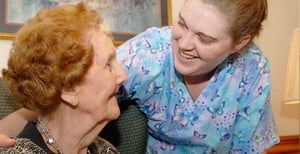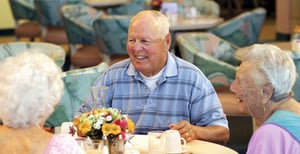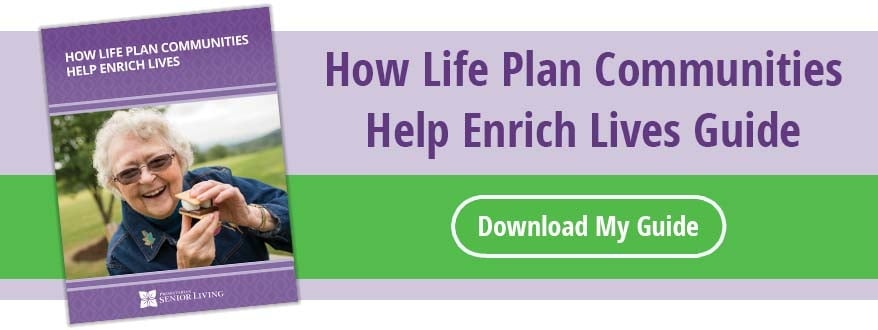
Effectively Managing Pain to Improve Quality of Life
When you are in pain it’s safe to say you're not enjoying that part of your day and you are looking for relief. Unfortunately, preventing pain 100% of the time is not possible. The good news is that it is possible to effectively manage pain. That was the goal for staff at Presbyterian Senior Living’s Windy Hill Village in Phillipsburg, PA. This goal was established after an annual survey in which some residents at Windy Hill Village reported higher than average long-term moderate to severe pain.
“Few indicators have as direct an impact on the quality of life of a resident as pain,” Jessica Coover, Director of Nursing at Windy Hill Village says. “By effectively managing and reducing pain, the obstacles that prevent the individual from reaching their full potential can be reduced, thereby leading to measurably higher happiness and quality of life.”
An interdisciplinary team recognized pain management as a serious concern that had the potential to impact the overall comfort levels and quality of life of the residents. The team made the decision to develop a Performance Improvement Plan, and set out to assist with pain management and relief for residents.
The interdisciplinary team came up with different methods between four different disciplines to reach their goal:
- A medical review
- Therapy treatment
- Social service support
- Community life involvement
Medical Review
The medical review began by focusing on individuals who reported high levels of pain. Staff reviewed the residents’ medication regimen, evaluated their specific needs, and made sure everything the resident needed was being addressed. Licensed staff were also reeducated on the proper follow-up action, including focusing on non-pharmacological relief methods.
pain. Staff reviewed the residents’ medication regimen, evaluated their specific needs, and made sure everything the resident needed was being addressed. Licensed staff were also reeducated on the proper follow-up action, including focusing on non-pharmacological relief methods.
The team began to further explore each individual resident, looking at aromatherapy, compassionate touch, and planning specific pain-management intervention for times deemed most helpful for the resident based on ongoing staff assessments.
The Director of Nursing also monitored the resident’s use of medications. If an increase in usage or routine use patterns was noted, it was reported to the resident’s physician for further review. The physicians were committed to reviewing these concerns immediately, and often performed bedside visits at this time. A pharmacist was also asked to focus their attention on pain medication usage and recommend a routine medication regime as they deemed appropriate.
Therapy Treatment
A pain management therapy program was established to help with pain without medication. It focused on routines that the Occupational Therapist or Physical Therapist could use to decrease pain, increase functional ability, and increase quality of life. To determine who was eligible for therapy, a comprehensive evaluation was given to residents who reported high levels of pain. It assessed pain during functional mobility and activities of daily living.
Examples of therapies that were often implemented include stretching, splinting, range-of-motion exercises, behavioral/cognitive techniques, hot/cold packs, ultrasound and electrical muscle stimulation. After a resident had finished therapy, staff would check up on them every now and then to make sure that their pain continued to be managed through the established measures.
Social Service Support
As part of the Social Service role in the pain management process, the Social Service team reviewed resident reports each month to determine who rated highly for pain. A member of the Social Services team would then have a one-on-one meeting with those residents. The meetings would utilize cognitive behavior therapy to change how residents thought about their pain. Additional residents who could benefit from this program were gathered from morning clinical meeting discussions and physician/nursing referrals.
Community Life Involvement
 Windy Hill’s Community Life department offered Recreational Therapy to individuals who were identified by the interdisciplinary team and were receiving therapy treatment and/or social service support. Since the brain can only focus its attention on a finite number of things at one time, positive mental or physical distractions can inhibit the response to incoming pain signals. Activities included gentle movement to music (Tai-chi), relaxation, leisure education to reduce focus on pain, and participation in meaningful activities.
Windy Hill’s Community Life department offered Recreational Therapy to individuals who were identified by the interdisciplinary team and were receiving therapy treatment and/or social service support. Since the brain can only focus its attention on a finite number of things at one time, positive mental or physical distractions can inhibit the response to incoming pain signals. Activities included gentle movement to music (Tai-chi), relaxation, leisure education to reduce focus on pain, and participation in meaningful activities.
Residents reported substantial benefits from this group, with pain rates dropping anywhere from 1 to 3 points by session's end.
Outcomes
Surveys indicate that this program has been a big success. Reports of pain from residents dropped from 74% to 57%.
“We saw an improvement in the quality of life for those we serve related to more comprehensive pain management,” Coover siad.
To continue their success, Windy Hill Village plans to implement ongoing monitoring on a monthly basis of the Quality Measure Report to immediately address any new residents with all of the pain management resources available. They also plan to continue the interdisciplinary discussion of pain management in order to refine the process, and to continue staff education.
As part of our mission at Presbyterian Senior Living, we strive to provide compassionate, vibrant and supportive communities and services to promote wholeness of body, mind and spirit. Programs like this are just one of the ways we are able to do so. To learn more about how a CCRC can Enrich Your Life, download our free eBook below.
About Presbyterian Senior Living
PSL is a mission-driven organization that lives our values of integrity, mutual respect, creative curiosity, and connectedness. Building on a legacy of 96 years, we provide residential and care services to more than 6,000 seniors in 27 locations across the mid-Atlantic region of Pennsylvania, Maryland, Ohio and Delaware.


